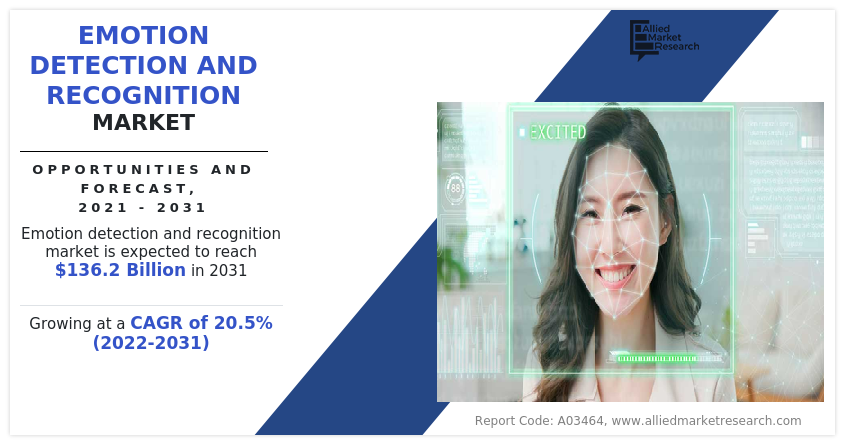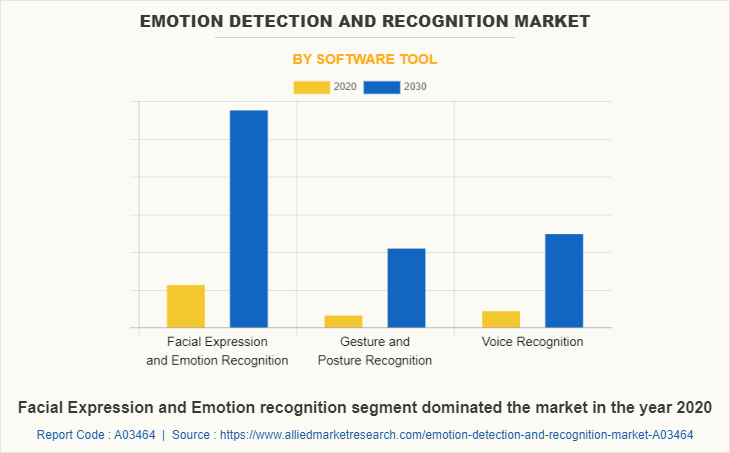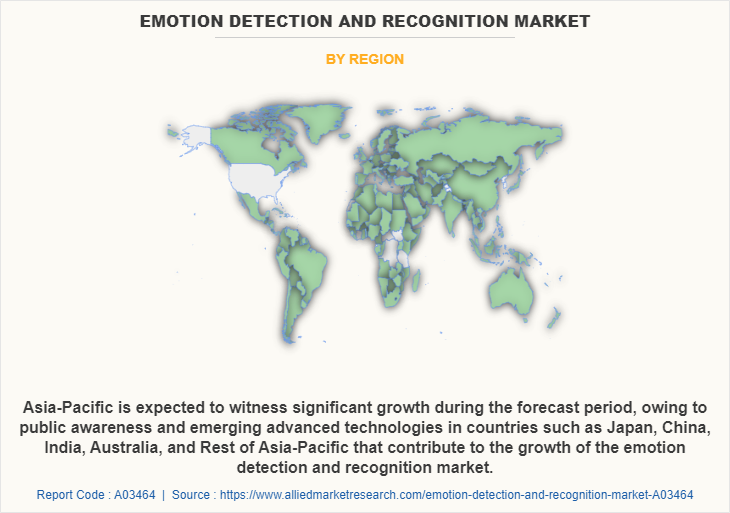Emotion Detection and Recognition Market Statistics, 2031
The global emotion detection and recognition market size was valued at $21.7 billion in 2021, and is projected to reach $136.2 billion by 2031, growing at a CAGR of 20.5% from 2022 to 2031.
Substantial growth of the Internet of Things technology, the increase in popularity of wearable technology drives the global emotion recognition and detection market. Moreover, the tremendous rise in the usage of smartphones helps the market to perform better. However, the high cost of application & functional requirements, misinterpretation in analysis of emotions restrict the growth of the market. Adoption of cloud-based technology provides growth opportunity for the market.

Emotion detection recognition (EDR) is a method used for detection and recognition of human emotions with the incorporation of technological capabilities, such as facial recognition, speech, and voice recognition, biosensing, machine learning, and pattern recognition. The study under consideration explores the global market for both EDR software and services that can recognize basic emotions.
The report focuses on growth prospects, restraints, and analysis of the global emotion detection and recognition market. The study provides Porter’s five forces analysis to understand the impact of various factors, such as bargaining power of suppliers, competitive intensity of competitors, the threat of new entrants, threat of substitutes, and bargaining power of buyers on the global emotion detection and recognition market trends.
The emotion detection and recognition market is segmented into Software Tool, Application, Technology and End User.
Segment Review
The global emotion detection and recognition industry is segmented on the basis of software tool, application, technology, end user, and region. Software tool covered in this study include facial expression & emotion recognition, gesture & posture recognition, and voice recognition. Application includes law enforcement, surveillance, & monitoring, entertainment & consumer electronics, marketing & advertising, and others (e-learning and video games). Based on technology, the market includes pattern recognition network, machine learning, natural language processing, and others (bio-sensors technology). The end users covered are commercial, industrial, defense, and others (government, retail, entertainment, and transportation). Based on regional study, the market is analyzed across North America, Europe, Asia-Pacific, and LAMEA.

In terms of software tools, the facial expression & emotion recognition segment holds the largest emotion detection and recognition market share, as it offers fast & accurate results, reliable matching, non-contact process, diverse applications (access control, border control, crime-fighting, and law enforcement agencies), which gain traction in the emotion detection and recognition market. Moreover, time fraud, better security, automated facial system, easy integration, and high success rate are some of the key benefits that supplement the adaptation of facial expression recognition solutions.
However, the gesture & posture recognition segment is expected to grow at the highest rate during the forecast period, as it offers the ability to communicate naturally with the technology through basic sign language, reduces the use of most prominent hardware devices, and assures good performance with fast and powerful results, reliability, and good feature extraction, which fuel the emotion detection and recognition market growth.

Region wise, the emotion detection and recognition market analysis was dominated by North America in 2021 and is expected to retain its position during the forecast period, owing to the presence of countries, such as the United States and Canada, which are home to the largest retail markets, with demand for IoT and smart wearables and high ad spending. Marketers in the region are among the global leaders in adopting technologies that enable gaining consumer insights.
The key players that operate in the emotion detection and recognition industry are Affectiva, CrowdEmotion, IBM Corporation, Kairos AR, Inc., Noldus Information Technology bv., NVISO SA, Realeyes, Sentiance NV., Sightcorp, and SkyBiometry.
Top Impacting Factors
Substantial Growth of the Internet of Things (IoT) Technology
Internet of Things (IoT) technology involves monitoring and responding to all devices in accordance with the emotion, moods, and actions of a person. There are devices that pass information to one another without human intervention, such as input from a sensor that regulates the output of an industrial process at a remote installation. Emotion-sensing technology is moving from an experimental phase to a reality. For instance, the talk with Siri is designed, and the way in which emotions are displayed on the mood-tracking app (Moodnotes). Such pioneering developments will reinforce the demand for emotion detection and recognition market worldwide.
In addition, the growing initiatives by the government to support technological development are further expected to drive the market. For instance, in February 2022, the central government in India launched a unique face recognition technology that helps in serving for life certificates, this is developed with the intention to ensure ease of living for retired and elderly citizens.
Furthermore, edge-based facial recognition is embedded in IoT devices, without the need for cloud processing. Devices like smart locks, mobile phones, point-of-sale (POS) systems, interactive kiosks, and digital signage is driving the demand in the market during the forecast period. Also, facial recognition technology equipped with IoT devices operate facial recognition with extreme precision in milliseconds. On top of considerably speeding up the process, the absence of cloud processing addresses data security issues and results in huge cost savings are positive factor which drives the growth of the market.
Increasing Popularity of Wearable Technology
Wearable technology includes sensors for tracking information, which detects physical traces such as heart rate, blood pressure, and skin temperature, which gives clues about mood. Human emotions such as facial expressions, tone of voice, body postures, and gestures are accompanied by physiological changes. Wearable gadgets with the help of emotion detection and recognition facilitate measures such as physiological changes and derive a conclusion, which is driving the emotion detection and recognition market growth.
Growing advancement in emotion detection and recognition by analyzing gesture control is more useful with the help of IoT. Thus, people want their wearables to be seamless, functional, and fashionable with IoT integration, which is driving the adoption in the emotion detection and recognition market. Facial recognition technology with gesture control is the first step, but aside from telecommunication, eye tracking is the end-all-be-all seamless control that is expected to drive market growth. Facial recognition uses vectors that map out facial characteristics and compare the data from multiple facial images to identify a single person. Affect recognition technologies, however, process facial expressions and muscle movements to predict different emotional reactions. The context in which a facial expression is displayed also plays an important role in wearables, which is aiding the market growth.
Digital Capabilities
Emotion detection and recognition systems are increasingly relevant in advanced technologies such as Artificial Intelligence (AI), machine learning, cloud technologies and automation. In conjunction with facial recognition technology, emotion recognition technology employs artificial intelligence to recognize and classify emotions into seven universal emotions or a combination of them based on the subject's facial expressions. Additionally, a relatively active area of computer vision research currently is AI emotion identification, which encompasses autonomous sentiment analysis from visual data and facial emotion detection.
Moreover, many organizations from this sector are adopting AI technology to provide effective solutions to users. For instance, in August 2022, Intetics introduced a new AI facial recognition and detection solution for enterprises. Such factors help to enhance the services through a better understanding of the users that drive the market growth. In addition, many sectors now use emotional AI products and solutions to create emotionally rich experiences. It can help in the diagnosis of neurological and mental diseases in the medical field. Encourage teachers to include students more deeply in their lessons and assist hiring specialists in finding the most qualified candidates.
Furthermore, machine learning in emotion detection and recognition is used to recognize patterns and process that data. By learning the meanings of the body language aspects (facial features, voice features, bio signals, posture, body gestures/movements, etc.) and applying this knowledge to the new set of data and information presented, ML-based apps can detect emotions. Recognizing emotions, machine learning is useful in this way.
Additionally, there are sophisticated algorithms that can extract and use face landmarks, voice features/activities, and body language such as deep learning. In deep learning, models show better accuracy than machine learning models for large sizes of text or data. According to the article published by Cornell University, in July 2021, recent technological advancements have generated a lot of interest in the use of deep learning techniques to identify the patient's emotions. Such advancements further contribute to driving the growth of the emotion detection and recognition market.
End-User Adoption
The growing technological advancements of emotion detection and recognition solutions by selected organizations are accelerating end-user adoption. Using advanced technology to identify emotions is one of the most exciting topics as it defines the relationships between humans and machines. Moreover, AI emotion recognition technology has been applied in numerous fields, including police interrogation and behavior monitoring in schools, in nations like China. For instance, in February 2021, Beijing's Niulanshan First Secondary School has a security camera that takes pictures, which are then fed into the Classroom Care System, an “emotion recognition” program developed by Hanwang Technology. It recognizes each student's face and analyses their behavior.
Additionally, the industry is transforming and introducing AI technologies, management, orchestration, and automation. With the introduction of emotion detection solutions. For instance, in June 2021, a Chinese company named Taigusys developed an AI emotion-recognition system that recognizes and tracks the facial expressions of many persons and produces detailed reports on each person to track their emotional state. The business believes it can assist police to reduce security concerns by tracking false smiles, mapping real emotions, and charting real emotions. Such innovations propel the growth of the emotion detection and recognition market.
Government Initiatives
Various companies and government bodies are collaborating to strengthen R&D in the software industry with evolving productive alliances that lead to indigenous design, development, manufacturing, and deployment of cost-effective products and solutions. For instance, in May 2021, Uyghurs in Xinjiang have been evaluated by a camera system set by the Chinese Government that employs AI and facial recognition to detect emotional states. Uyghurs are used by the Chinese government as test subjects in a variety of research. The province's residents are often monitored. Human rights organizations refer to the region's highly contentious "re-education centers" as high-security detention facilities, where it is believed that more than a million individuals have been detained. Furthermore, such initiatives taken via governments and public/private firms are propelling the growth of the emotion detection and recognition market.
Key Benefits for Stakeholders
- The study provides an in-depth analysis of the global emotion detection and recognition market forecast along with current & future trends to explain the imminent investment pockets.
- Information about key drivers, restraints, & opportunities and their impact analysis on global emotion detection and recognition market trend is provided in the report.
- The Porter’s five forces analysis illustrates the potency of the buyers and suppliers operating in the industry.
- The quantitative analysis of the market from 2021 to 2030 is provided to determine the market potential.
Emotion Detection and Recognition Market Report Highlights
| Aspects | Details |
| Market Size By 2031 | USD 136.2 billion |
| Growth Rate | CAGR of 20.5% |
| Forecast period | 2021 - 2031 |
| Report Pages | 232 |
| By Software Tool |
|
| By Application |
|
| By Technology |
|
| By End User |
|
| By Region |
|
| Key Market Players | Intel Corporation, Affectiva, Kairos AR, Inc., Sightcorp, IBM CORPORATION, NVISO SA, Noldus Information Technology BV, Realeyes, Sentiance NV, SkyBiometry |
Analyst Review
Facial emotion recognition is an AI technology used to analyze a person’s face and interpret their expressions. Using these analyses and interpretations, the emotion a person is experiencing can be concluded with the use of technology. Emotion recognition can be done using texts, images, videos, speeches, and conversations. It also provides benefits to many institutions and aspects of life. It is useful and important for security and healthcare purposes. Also, it is crucial for easy and simple detection of human feelings at a specific moment without asking them.
Key providers of the emotion detection and recognition market such IBM Corporation, NVISO SA and Sentiance NV. account for a significant share in the market. With the growing requirement for emotion detection and recognition, various companies are establishing partnerships to increase their capabilities. For instance, in July 2020, Realeyes entered into partnership agreement with NEC Corporation, a leader in biometric authentication and video analytics technologies. This partnership helps to jointly develop and distribute emotion analysis solutions globally. Wireless 5G technologies and the COVID-19 pandemic have created a new way of life, where virtual meeting experiences are necessary and have become the default method for communication, collaboration, entertainment, and learning. Technologies that can help companies to safely and effectively understand how users are interacting with such services, and to respond to their needs, are now essential.
In addition, with further growing in investment across the world looking at the increase in demand for emotion detection and recognition systems, various companies are expanding their current product portfolio with increasing diversification among customers. For instance, in June 2019, Realeyes raised funds from Draper Esprit, the VC arm of Japanese telecom giant NTT Docomo, Japanese VC fund Global Brain, Karma Ventures, and The Entrepreneurs Fund to help brands detect emotion using AI on facial expressions.
The emotion detection and recognition market is estimated to grow at a CAGR of 20.5% from 2022 to 2031.
The emotion detection and recognition market is projected to reach $ 136.24 billion by 2031.
Substantial growth of the internet of things technology, Increasing popularity of wearable technology, and rapid increase in the usage of smartphones across the globe.
The key players profiled in the report include IBM Corporation., Affectiva, Intel Corporation, Kairos AR, Inc., Noldus Information Technology bv., NVISO SA., Realeyes, Sentiance NV., Sightcorp, and SkyBiometry.
The key growth strategies of emotion detection and recognition market players include product portfolio expansion, mergers & acquisitions, agreements, geographical expansion, and collaborations.
Loading Table Of Content...


